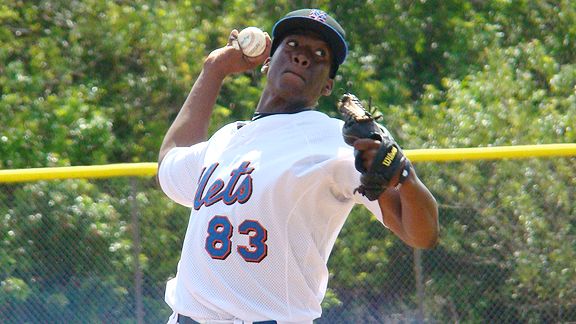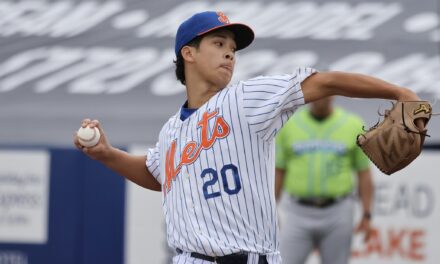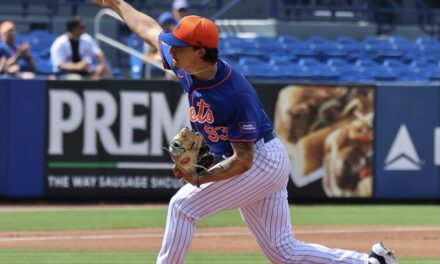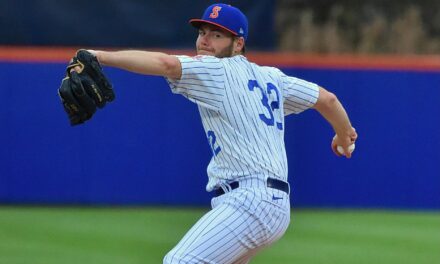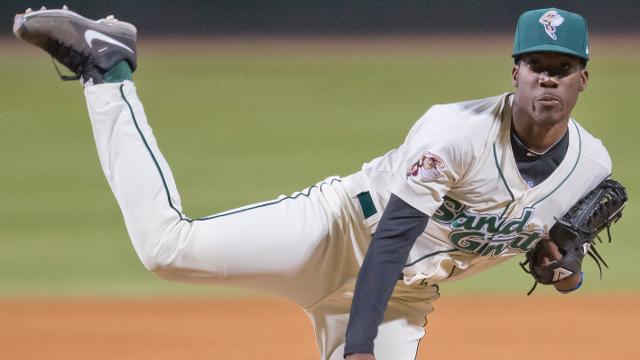
The beginning of last week I had just finished reading an email from Mets pitching prospect Akeel Morris. He had kindly consented to doing an interview with me for MMO. I then went into the MMO Interview Archives, and way back on page 16 or 17, I found the first interview I did with Akeel when he was toiling as an 18-year-old in the rookie league and I was surprised to see it was over three years ago… Wow, time sure flies when you’re young, and a Met, and are living the baseball life.
In those three years Morris has come a long way. He utterly dominated the South Atlantic League this past season, was selected to the All-Star team, pitched in the play-offs, and led the SAL in Saves, strikeout rate, WHIP, ERA, total and strikeouts for a reliever. In recognition of his achievements, Morris received the prestigious Sterling Award, given by the Mets Organization to the best player at each minor league level.
Last week, the Mets even made the decision to add Morris to their 40-man Major League roster. That speaks volumes about what the Mets think of this talented right-hander.
When drafted by the Mets in the 10th round in 2010 out of Amalie High School in St. Thomas, Virgin Islands, Akeel was just a raw, untested young pitcher with a very live arm. In our previous interview he explained that he was working on repeating his delivery and his overall command.
It seems to have worked out pretty well so far because in 2014 , while closing games for Single-A Savannah, Akeel led the league in Saves (16), ERA (0.63), WHIP (0.72), and K/9 (14.1). Yes that last stat is a real eye-opener, 14.1 strikeouts per nine innings. His 89 K’s in 57 innings was so far out of the ordinary that the closer with the next highest strikeout total in the league had 66 K’s in 58.2 innings.
So here we go… Let’s check in with this exciting young man and see what he has to say about his truly incredible season Enjoy…
Petey: Hi Akeel, thanks for taking the time to do this interview for all of us at MMO, all the readers will really enjoy hearing from you.
After your amazing season this year in Savannah, there is a great deal of buzz about you in and around the organization not to mention the rest of baseball. How do you feel about the year you just had now that you have had a little time to decompress?
Akeel: The year I had personally was for me a great accomplishment. To see what I could do in a full season, the competition level and just moving up and being successful at every level for me is an accomplishment. I’m happy about that and excited to keep moving up and challenges, and challenging better hitters. So that really was an accomplishment for me personally. About the baseball world, it was a really great year, for me to make the All-Star team and post-season All-Star team, and the Sterling Award. On top of a great season that was even more than I could have asked for.
Petey: Well all those awards and accolades were well deserved my man. It is great to see your hard work and dedication paying off like that. Are you going to play any winter ball?
Akeel: No I’m not going to play any winter ball.
Petey: I went back in the MMO archives to find the interview you and I did before and I was shocked to see that it was just over three years ago, October 2011! A lot has gone down since then. It seems things really started to roll when you were switched to relief, that was the beginning of 2012 I think?
Akeel: Yeah I was put in a piggy-back role in 2012 so I was coming out of the bullpen. Yeah so you could say I started relief in 2012. And 2013 I was with the Brooklyn Cyclones. I wasn’t on a full relief schedule there, the appearances were just as much but I was out of the bullpen. I was on a starter’s schedule but I was piggy-backing as well. But yeah this year in Savannah was the first full year in the bullpen. Doing back-to-back outings, that was a big difference. You’re on a throwing program everyday, and you got to pitch that night. You have to learn how to pace yourself and how your arm is feeling going into the game and stuff. It was also a learning experience for me coming out of the bullpen.
Petey: Yeah and if you’re facing the same team two nights in a row you have to be able to show them something different right?
Akeel: Exactly. So it was definitely a learning experience.
Petey: Was there a moment when things really started to ‘click’ for you, and did that help your confidence?
Akeel: Confidence-wise, when I’ve got my good stuff, on most nights consistently like that I kinda got a feel for. I know what I gotta do to have this and this, and you’re not going to have it every night. But when you can have it on most nights that’s all you can really ask for, and you have to battle it the other nights. I got a feel for how I need to be, what I need to be, and what I need to do, to have my stuff be effective most nights, you know? I guess that’s what really ‘clicked’, learning about myself.
Petey: That’s really cool man. So how would you describe your mindset when you are entering a game as a closer? How is it different from starting a ball game?
Akeel: Yeah, it’s definitely different, I mean as a closer or even late in a ball game, you’re going to come in when the game is tied or most likely when your team is up and your like okay, they play nine innings, you’ve got to shut it down. No free passes, no anything. You don’t want to give them any momentum, you know? It’s really just like shut it down, shut it down, that’s all you’re really thinking.
Petey: Being aggressive.
Akeel: Yeah. Basically that’s a simple message in my head, I got to shut it down, go right after these guys. Don’t give them any free passes.
Petey: Is there any ritual or mental prep you do in the bullpen before coming in with the game on the line?
Akeel: Mental preparation, I mean that’s gradual throughout the game. As the later innings come buy I start to get a little more locked in. I start to move around in the bullpen, even as the the game is close in the eighth inning sometimes I just sit around and it’s about mentally locking in. When the whole process really starts for me is before I get on the mound to warm up. Sometimes you don’t have as much time but it doesn’t feel like that once you mentally prepared yourself. So that’s what works for me.
Petey: When we did our last interview for MMO we discussed your pitches at the time. I would imagine they have come a long way since then. Back in 2011 this what you said on the subject:
“As of now I’m throwing a fastball, curveball and a change up. My fastball is usually low to mid 90′s, it peaked at 96 this season. My curve is mid to upper 70′s, and change up is upper 70′s to low 80′s.”
What kind of speeds and movement is your fastball exhibiting these days?
Akeel: My fastball has been sitting at 93-95 mph this season, topped out at 97. Most people tell me it has like a downhill plane, most times it has life to it. Sometimes my catcher will tell me it looks like it’s coming down and looks like it’s going to hit the ground, but it just rides out and it reaches the catcher. So it kinda looks like it’s downhill, downhill, downhill, but it somehow rides out to the plate. So I don’t know how to explain it, that’s what he told me.
Petey: Wow, it sounds like the pitch has natural rise or carry but you’re keeping the ball down in the zone as well.
Akeel: I guess so yeah something like that.
Petey: That’s a four-seam fastball?
Akeel: Yeah I throw a four-seam fastball.
Petey: How bout your change-up? The last time I talked to you it was something you wanted to focus on.
Akeel: The change-up has been really great. Sometimes I keep it down and there’s not as much movement, but it’s so much slower than my fastball and it looks so much like my fastball too, it’s hard for hitters to pick it up. And sometimes it’s even better when it has that drop-off to it. Sometimes it just drops off the table and they swing over it. And sometimes it doesn’t even have that much movement but it’s so slow they don’t see it and can’t put a good swing on it.
Petey: And your arm-speed? It’s the same as with the fastball?
Akeel: Yeah my arm speed is the same.
Petey: That’s awesome. Now what about your breaking pitches?
Akeel: I throw a slider. The slider has really come along a lot more this year. I started throwing it last off-season and at the beginning of this season I didn’t throw it as much. But when the second half came I started to bring it out and throw it, and it really started to develop a lot more. I even got a feel for it where I was throwing the slider even more than my change-up at times. And I love that feeling because I didn’t even have to depend on the fastball/change-up combination. I could go fastball/slider combination and when I mixed it in with the change-up too, it was even a lot better.
Petey: Yeah and the results from this last season certainly attest to that. Say Akeel, what are some of the things you hope to accomplish in your development this upcoming season? Do you set any goals for yourself?
Akeel: This upcoming season I would really like to get better control of my slider. Like be able to throw it for a strike more often. I would throw it for a strike at times but most times I’d throw them a slider it would break outside the zone and they would swing over it or they would take it. But it was more for them to see the pitch. So if I can throw it for strikes more often that’s what I really want to do. So basically just develop the slider some more.
Petey: Are you able to throw the slider when you are behind in the count?
Akeel: Yes I’ve thrown it in various different counts and I feel that’s a big thing about pitching too. I feel whatever pitches you have you need to be able to throw it in any count. So yeah I have been working on that and I have thrown it in different counts.
Petey: Is there any one coach, or coaches that have helped you significantly since joining the Mets organization, in regards to your development?
Akeel: Coaching-wise, I’ve been with Jonathan Hurst for two years in Kingsport, he helped me a lot, and different coaches in extended spring training. But one of the coaches who really took a lot of time out with me and worked on mechanics while I was in extended spring training day-to-day was Miguel Valdez. He was the pitching coach for short season and I mean he’d really break down my mechanics for me to understand it and I worked on it. It took a little time but it definitely paid off to where I understand my mechanics and I can see what I’m doing wrong. And as soon as I figured that stuff out it’s been going a lot better, a lot better. So Miguel Valdez has really helped me out a lot.
Petey: You were on a very talented Savannah ball club this past season, lot’s of excellent position players and pitchers. And of course you guys made the SAL playoffs. But let’s focus on the pitching staff for a moment. As someone who watched your starting pitcher’s performances in every game, are there any that stand out for what they bring to the table?
Akeel: That’s really hard, I mean we got so much talent. Actually the starting pitching, I mean for the full year I would say, John Gant for sure. He impressed me. I mean anytime he’s going into the game your guaranteed he’s gonna go at least six innings. He usually goes deep into the ball games and he’s keeping the score close, giving your team a chance to win. So John Gant really impressed me with his consistency and being able to do that. Other pitchers, I like Robert Gsellman a lot too but he got hurt a little bit into the season. But I mean he really pitched good, he had a good year as well.
Petey: Yeah a lot of Mets fans that follow the Mets Minor League teams are very high on those two guys.
Akeel: And also Kevin McGowan too because he had a game, he went deep into the ninth and I like when your starting pitcher is out there. His pitch count was up and he couldn’t pitch anymore in the ninth inning if he wanted to. And I had to come in and close the game, and he didn’t even want to get off the mound, he wanted to finish the game. So when you have your starters out there with that sort of fire, it pumps you up more to come in and save their game.
Petey: One more question. Now that you are a professional ‘closer’ Akeel, do you ever imagine yourself on the mound in the 9th inning of the World Series trying to preserve a one-run lead? How does it work out? Ha ha!
Akeel: Definitely, as a kid people have those fantasies, whatever scenario it is. Fortunately for me I was always pitching, since I became a pitcher that’s always been the fantasy. The World Series, last inning, game on the line and they call on you. I mean how that turns out is I’m just ready to pitch. Like I said, always in the minors to shut it down, and it goes well for me in my mind.
Petey: That’s is awesome man. Seriously Akeel, I want to thank you again for being so accommodating and taking the time to do this interview. You have always taken time out to talk to me and my colleagues at MetsMerized Online and we all really appreciate it.
Akeel: Alright man sounds good, anytime. I’m already psyched.
* * * * * * * * * * *
I hope you enjoyed our interview. Although Morris is still a year or two away from the big leagues, the fact that the Mets found it necessary to protect him from the draft this winter by adding him to the 40 man roster shows how highly regarded a prospect he truly is. I look for him to be fast-tracked all the way to AA this year. He’ll surely have a chance to get his feet wet in the Florida State League coming out of spring training, but I would be very surprised if he doesn’t wind up at Binghamton by mid-season at the latest.


